New Britain Island and East of Lae
Diving Beyond the Rain Forest ---Papau New Guinea's Far-out Live-aboards
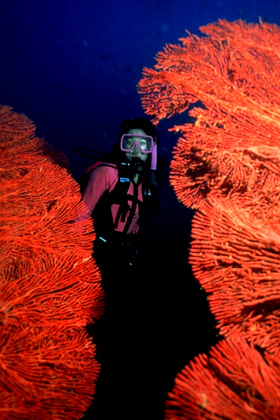
Heavy mist settles on the leaves of the Sago palms as the rain forest awakes for another day. The cassowary sits upon its ostrich-like eggs while the tree kangaroo munches leaves in the palm's shade. The Huli Wig people who live in the highlands of Papua New Guinea prepare to go about their morning rituals. The jungle air is filled with the sounds of the brightly plumed bird-of-paradise. Not far to the east, in the Bismarck Sea, another world is waking.
Situated just below the equator in the South Pacific, Papua New Guinea is one of the top dive locations in the world. The best way to experience this underwater world is to dive off live-aboards, which are able to access even the furthest reaches of the islands. Many dive destinations around the world offer sheer walls, drift dives, large pelagics and colorful soft coral growths. But it is Papua New Guinea where the adventure is enhanced by the excitement of diving so far from civilization.
Weeks before the trip, I prepared my mind and body for an adventure of a lifetime to wander and dive through one of the last great wilderness areas. In the short period of three weeks, I planned to dive two major areas and trek the highland jungles. A scatter of travel guides and dive magazines lay on the floor all around me, as I tried to visualize what it would be like to immerse myself within a sea of stunning images and constant adventure.
Little wonder it takes more than a thousand underwater photographs for editors to select just one for publication. How does one capture the essence of the adventure and excitement in a single image? Being totally taken by the beauty of the Papua New Guinea reefs as seen through the eyes of the world's best photographers, I was surprised to find the reefs not to be the wall-to-wall splendor pictured within the folds of National Geographic Magazine.
Ever hike a forest and thrill to small arrangements of ferns and flowers standing out among the mono-green vegetation? I delight in finding stands of towering sponges, massive gorgonian fans and walls of soft coral. What makes Papua New Guinea one of the top destinations in the world is the impressive quantities of these 'diamonds-in-the-rough.' It is not just the adventure of discovery but the rewards when discovery yields such splendor.
Northeast of New Britain Island
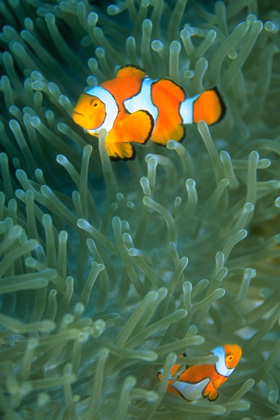
Far out in the Bismarck Sea lay the uncharted waters of the Fathers. The waters surrounding New Britain Islands are among the richest in the world and a single island reef can be known to harbor a greater diversity of coral than the entire Caribbean. We traveled east through Kimbe Bay from the Walindi Lodge to Restoff Island to Oto's Reef, past Agu Reef, towards the unsurveyed Fathers. The Fathers consists of several tall volcanoes, the highest of which is more than 2,500 meters. Fairway Reef is south of the Fathers but still close enough to gain an excellent view of the volcano. At times, smoke and blasts of fire can be seen coming from these ageless giants. We dine in their shadow with the warm Bismarck Sea at our feet.
Diving to the west of this small group of volcanoes requires the keen skills of the live-aboard captains to locate rich coral reefs that hide just below the surface. A series of moorings have been installed to limit reef damage and to prevent future crowding, though that is not much of a problem today. These are not frequented waters, and during our week's stay we did not see another boat of any kind. Even the seabirds have found other more familiar roosts.
Moving north towards the Fathers, we moored at Shady Dog Reef. As we dipped below the surface, a 2-meter silver-tip shark greeted us as it sensed it might get to feed. Two quick circles and it was gone. You must be ever-vigilant, for beyond the next turn in the wall may await a large silver-tip or black-tip shark. If you are quiet, and brave enough, you can approach these impressive creatures--almost within arm's reach.
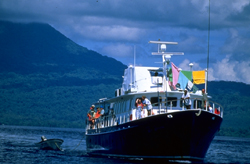
Dive sites with exotic names, such as Vanessa's Reef, Kirsty-Jane, Belinda and Christine, hint of the beauty that awaits below. Jackie's Knob, a little sea mount, is covered with cleaning stations and is a-bustle with fish of every description. There were so many that it was not a station, but a cleaning depot. Cleaner wrasses were hard at work as the fish lined up for their turn at the cleaning stalls.
Night dives are very special treats as a different world inhabits the shadows. Three Spanish Dancers are known to reside among the recesses of Flamenco Reef. Imagine the thrill of dancing with the "red lady" of Flamenco Reef--the lady in her red dress and me with my camera! The midwater dance in-the-dark showed the grace and elegance of this beautiful nudibranch. I sensed she was trying, so I gently returned her to her resting place--for yet another dance.
The PNG reefs are alive at night with a completely different cast of characters. An octopus lay flattened in front of its lair, crabs poke their heads and claws from surrounding crevasses, and deadly poisonous cone shells wander along the bottom. A large cuttlefish lay still, camouflaged against a rocky backdrop. Slowly, it began to move--I traced its search for food. All of a sudden, it changed to a brilliant red color and snatched a fish from under a small coral head! I followed this happy satisfied cuttlefish as it swam away with the fish's tail sticking out of its horned beak.
I awoke early one morning in anticipation of yet another day of surprises. Clearing morning clouds revealed one of the old Fathers with his steady stream of smoke--peaceful, yet warning. A pod of fifty Spinnaker dolphins broke the surface, casting reflections in the sparkling Bismarck Sea. I savored the quiet of the early hour as four dives before lunch were planned.
I always enjoy the dives before breakfast to watch the reef awake. Searching along the reef, I came across a large red tube sponge. On its tip was a black and green featherstar Chrinod. At its center a swollen green sack was ejecting little globs of eggs. Buried at the base of the chrinod I found a 2-centimeter Elegant Squat Lobster whose cast of colors made the crab almost invisible.
The captain of the M.V. FeBrina, Alan Raab, has been training a couple of two-meter silver-tip sharks. After breakfast it was time to feed the sharks. Once in the water, little silver-tips circled within centimeters, anticipating breakfast and growing impatient. Alan rigged a pulley system to lower the bait and, once in place, the show began. As most open-water feeds go, the bigger sharks have-at-it first, thrashing their heads from side to side to rip big chunks. Small scraps settle but are quickly devoured by the on-lookers waiting for handouts. Without the slightest fear, a large Tritan Triggerfish was in the thick of it, competing with fish many times its size. As quickly as it began, it was over. All that was left to do was to search the crevasses below for any remaining scraps.
Tari Valley in the Central Highlands
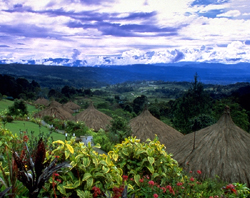
Of the many advantages of diving off live-aboards is the opportunity to dive the far-away reefs, and to do as many as six dives in a day. But there comes a time when you just have to dry out. The perfect retreat is in the central highlands at the Ambua Lodge. High in the dense jungle, the cool mountain air refreshes with green landscapes as we enjoy adventures with the local people.
On the horizon, the barren landing strip in the Tari Valley comes alive with brightly-garbed Huli Wig people. Crowds of people dressed in native clothing with umbrellas and daggers made from the leg-bones of Cassowaries, surround the barbed-wire runway daily to await curious visitors. Once on the ground, we squeezed past the crowds to the Ambua’s transports, clutching our valuables.
The first White Man contact was as recently as 1935--the last race to evade discovery. Now western world influence is having a dramatic affect on the future of the Huli Wig people and their traditions. Each day, we visited a small family group to hear them sing, tell stories and perform wedding ceremonies.
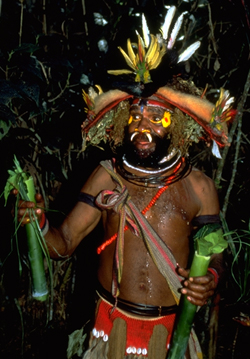
I especially enjoyed the visit to the local Witch Doctor to learn of his healing methods and view the family album of five generations of his ancestors' skills. He led us through the jungle to a shrine in the side of the mountain where he described the spiritual uses of five meteorites his ancestors collected over the last thousand years. Powerful spells can be cast for the fee of a few pigs. What a deal!
We filed into our safe haven for another day-long bus ride through the Tari Valley countryside. The rutted roads which often narrow to one lane take their toll on the busses. With only a single gas station in the area, we were told that the bus had one bad tire. But not to worry, for it also had a new spare. As if on cue, we drifted to a stop as the old tire finished its service. So we began yet another adventure into a hostile but intriguing land. We were most fortunate to be able to view and record a small glimpse into a way of life that may well be lost in just a few short years.
Diving East of Lae
The beauty and excitement of the Papua New Guinea reefs extend both above and below the water's edge. Diving the area to the east of the town of Lae on the mainland, from Salamaua north to Tami Island, added to the already long list of exciting dive sites.
Halfway Reef is, yes, halfway between Sammura and the town of Lae on the mainland. This coral growth rises out of the deep to within 30 meters of the surface. Three knolls poke towards the surface adorned with large soft corals of purple and pink. The residents include three species of lion fish and an assortment of anemone fish. Close to shore the visibility can be variable from snowstorms to crystal clear. Diving these three hills--which are separated by narrow valleys--became one of the most memorable of dive sites. Descending into the darkened water along the float line, the first of the hills came into view. Playful lion fish circled a group of anemones without a hint of our approach. It is common to see at one time 3-4 large lion fish in quiet suspended motion.
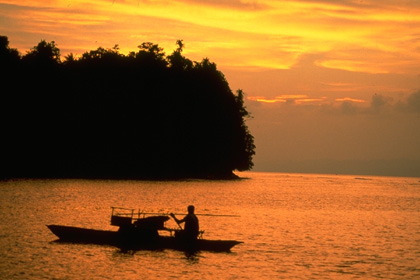
Out of the pages of James Michener's south seas novel, Tales of the Pacific, the splendor of Tami Island's tropical paradise comes alive. For most of his life, M.V. Barbarian II live-aboard’s captain, Rodney Pearce, has been diving these waters. He shares with us one of the very special places on earth and his special place. He knows the lagoon well and must navigate the channel with the tides. Once inside, you enter a world of dreams. The hand-built Barbarian is adorned with rosewood paneling and salvaged portholes throughout, completing the image of a South Seas adventure. At dusk, the local wood carvers paddle their out-rigger canoes to bring us an assortment of hand-polished Kwila bowls and spoons in trade for a small handful of coins. Into the dark, the merchants carry their wares to our floating market.
On the last day, as I was resting on the sunlit deck atop the Barbarian, I spied a flaw in the veneer of the Lae coastline. Although most logging is done within the jungles, there are signs along the rivers and shores. Rodney has dived these waters for more than 30 years and has begun to worry about logging impacts. "Even waters five miles offshore are not as pristine as before the loggers came," he says. Although he has no hard evidence, he knows that the visibility is not what it once was. Especially here, in the top dive area of the world, we must be ever vigilant to protect the reef and enjoy yet another day.
In my short stay, I was able to sample just a portion of this unique world. From the luxury of the live-aboards, some of the best diving in the world is yours to enjoy. Professional underwater photographers try to capture the beauty of Papua New Guinea reefs and editors distill thousands of photos that adorn the story. But the real excitement begins the moment you leave behind the pages of magazines and actually dive the remote reefs beyond the rain forests.
Story and photography by Robert Aston. All rights reserved. First published in Asian Diver Magazine, February/March 1998
